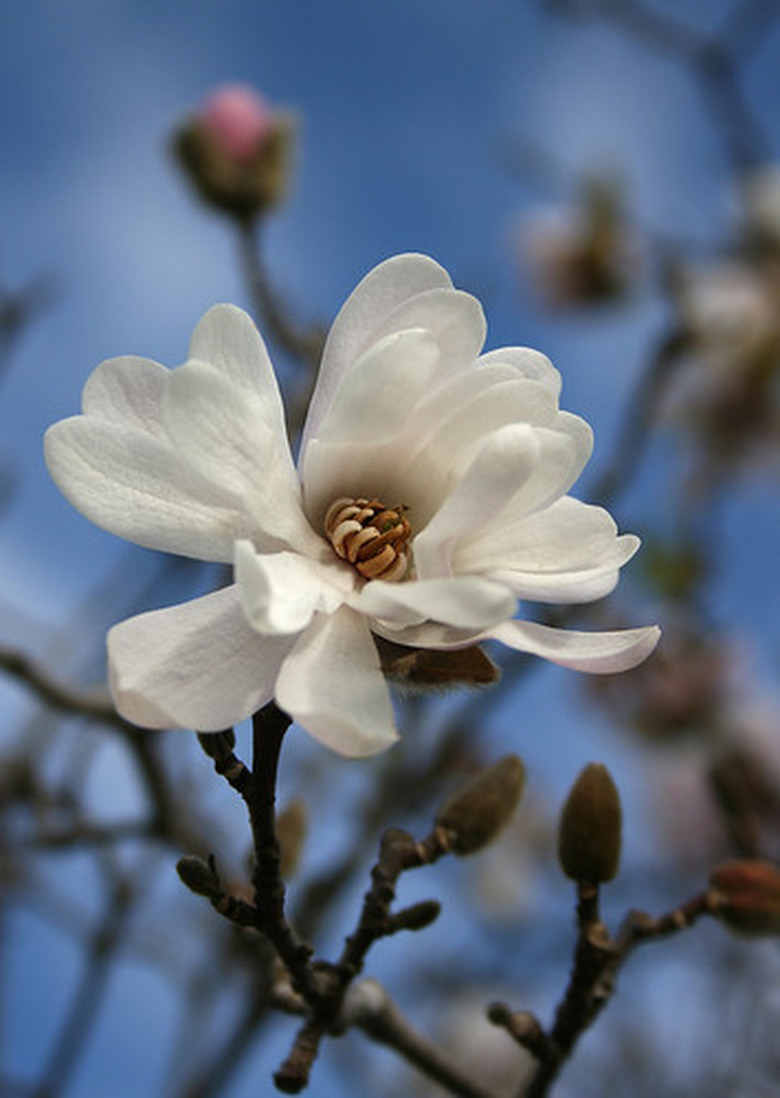Treatment Of Magnolia Tree Disease
The magnolia tree is naturally resistant to many diseases that commonly infect trees. Treatment for most diseases that effect the Magnolia involve simple pruning, fertilizing and watering. But an insect known as the magnolia scale can wreck havoc with the heartiest of these waxy-leafed trees, and a fungus called verticillium wilt can attack the tree from its root system.
Magnolia Scale
The magnolia scale is one of the largest insects native to North America. The females can reach one-half inch in length at maturity. These bugs suck the fluids from the branches and can kill the tree if left untreated. Their colors vary with their gender and stage of development, ranging from opaque white, to tan, brown, yellow or pink. They tend to cluster in large groups on branches of one to two years of age.
- The magnolia tree is naturally resistant to many diseases that commonly infect trees.
- The magnolia scale is one of the largest insects native to North America.
Horticultural oils, also known as "summer" or "dormant" oils, can effectively kill magnolia scales if applied at the right time of year. According to Paul A. Horton of Cornell University's Entomology Department, "Efficacy of horticultural oil against target pests often requires application at their most sensitive life stage. For example, scale insects are particularly susceptible to oils during the crawler stage, which occurs right after egg hatch."
Apply horticultural oils to scale-infested magnolia trees during August, November and March, or spray chemical insecticides during late August or early September, when the newborns have settled on branches for the upcoming winter.
Verticillium Wilt
Verticillium wilt is a fungal disease that may cause death of a few branches, an entire side of the tree, or the whole tree. Symptoms may include poor growth or minor browning or burnt appearance on branches or foliage. Remove affected branches and fertilize with a high nitrogen fertilizer. This disease is resistant to fungicides. Because verticillium wilt attacks through the root system, it is difficult to control.
- Horticultural oils, also known as "summer" or "dormant" oils, can effectively kill magnolia scales if applied at the right time of year.
- Verticillium wilt is a fungal disease that may cause death of a few branches, an entire side of the tree, or the whole tree.
Pests with Natural Predators
Another type of sap-sucking insect found on magnolia trees is the tuliptree aphid. Fortunately, this aphid has several insect predators, including ladybugs and certain wasps, which will usually provide natural control of the aphids. Tuliptree aphids can vary in color. They grow to about 1/8 inch long, with soft, pear-shaped bodies, long legs and antennae. They may or may not have wings, but all have cornicles, which are paired tube-shaped formations that grow past the end of their bodies.
If your magnolia tree is still small, wipe the affected branches down with a damp cloth to remove the aphids. For larger trees, a strong spray with a hose may do the trick. In more severe cases, prune the affected branches, or contact your local extension center for information about effective chemical treatment for tuliptree aphids.
- Another type of sap-sucking insect found on magnolia trees is the tuliptree aphid.
- In more severe cases, prune the affected branches, or contact your local extension center for information about effective chemical treatment for tuliptree aphids.
The magnolia leafminer is a weevil that feeds on leaves and buds. It is most commonly found in Florida. Certain species of wasps will help control the leafminer population by attacking the larvae; however, chemical treatment may be necessary in extreme cases.
Other Damaging Pests and Diseases
Spider mites, or two-spotted mites, will eat your magnolia flowers and weave tight webs around the leaves of your magnolia tree. They appear as tiny brown or yellow spots, but can take over your tree within a very short time. Treatments include spraying the tree with a 1:3 ratio of alcohol to water, spraying with a miticide containing pyrethoids, or spraying with an insecticidal soap.
A canker is a depressed area on a woody area of the tree caused by fungi. It can cause leaves and flowers on infected branches to wilt and die. Cankers on branches can be pruned out. If the canker is on the bark of the tree, cut into the wood around it to remove the affected area.
- The magnolia leafminer is a weevil that feeds on leaves and buds.
- Certain species of wasps will help control the leafminer population by attacking the larvae; however, chemical treatment may be necessary in extreme cases.
Non-Damaging Diseases
White spots on the leaves of your magnolia tree are a nuisance that can be caused by fungi or bacteria. They won't damage the tree and almost never need treatment.
Lichens, a combination of algae and fungi, appear as green-brown spots on magnolia leaves. While the may be a bit unsightly, they do no actual damage to the tree. Apply copper hydroxide fungicides according to directions during the fall if you find the spots too unsightly.
References
- Paul A. Weston; Department of Entomology, Cornell University; Ithaca, NY
- Magnolia Scale
- University of California Agriculture and Natural Resources Dept.
